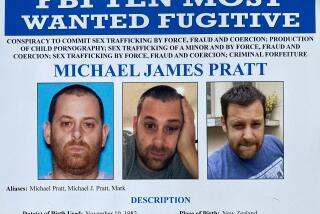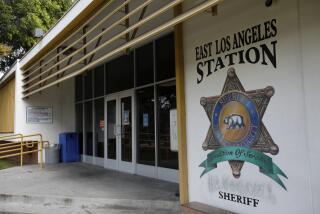Pratt Trial Witness’ Reliability Questioned
- Share via
SANTA ANA — The eyewitness who identified former Black Panther Party leader Elmer “Geronimo” Pratt as a killer was considered unreliable by Santa Monica police, a veteran Los Angeles County deputy district attorney testified Tuesday.
Ronald “Mike” Carroll said Santa Monica police had “little confidence” in Kenneth Olsen’s ability to make an identification in the murder of Caroline Olsen, who was killed on a Santa Monica tennis court in December 1968.
“Olsen was a little flaky,” Carroll said. “I didn’t like the man. We had a personality conflict.”
Carroll was the deputy district attorney who took the Caroline Olsen murder case to the grand jury that indicted Pratt in December 1970. Kenneth Olsen, who survived five bullet wounds from the robbery that claimed his wife’s life, provided critical testimony at Pratt’s trial in 1972.
More than three years after he and his wife were robbed of $18 and shot in cold blood, Olsen testified that Pratt was the gunman. Pratt’s lawyers say neither they nor the jury knew then that Olsen had previously positively identified another suspect as his wife’s killer.
Carroll’s testimony Tuesday came at a hearing in Orange County Superior Court on whether Pratt’s conviction should be overturned. The hearing was moved to Orange County because Los Angeles County Superior Court Judge Richard P. Kalustian, the deputy district attorney who prosecuted Pratt, was a witness.
Olsen’s testimony was a key factor in getting Pratt juror Jeanne Hamilton to change her vote to guilty during deliberations nearly 25 years ago. Hamilton, who now believes Pratt is innocent, has said she will never forget when the jury foreman fixed her in his gaze and sternly asked: “If someone shot your husband, wouldn’t you remember his face?”
Pratt, 49, has steadfastly denied any involvement in Caroline Olsen’s murder.
Ex-Panther and former Los Angeles County Sheriff’s Deputy Julius C. “Julio” Butler first implicated Pratt in the Olsen murder, saying Pratt had confessed the crime to him.
Butler’s credibility as a witness has been an issue in the Pratt case.
At Pratt’s murder trial, Butler testified that he had never been a “snitch” and had never informed on anyone. But FBI documents released seven years after Pratt’s conviction show that Butler had provided agents with information for more than two years before Pratt’s trial.
Judge Everett W. Dickey, who is presiding over the hearing, raised his own questions Tuesday about conflicting testimony from Butler and another witness, retired Los Angeles County district attorney’s detective Morris “Morrie” Bowles.
“It is always unfortunate when the court has to conclude that someone is deliberately lying on the witness stand,” Dickey said in open court. But there is no way to reconcile conflicting testimony from Butler and Bowles, Dickey said.
Butler testified that he first met Bowles--a district attorney’s investigator in the Pratt trial--during the late 1950s, when Butler was a sheriff’s deputy and Bowles was a Los Angeles police officer. Butler said he would see Bowles at popular restaurants and clubs in central Los Angeles.
In late 1970, as the Olsen murder case was going to the grand jury, Bowles gave him $200 to buy a gun, Butler testified, saying he feared for his life then because Panthers had threatened him.
When Bowles testified, he said the first time he had ever met Butler was when he served him with a subpoena in the Pratt case. Bowles said he had never known Butler when he was a sheriff’s deputy.
Other retired law enforcement officers have testified that Bowles lived in the San Fernando Valley and that they did not recall seeing him in the Central Los Angeles restaurants and clubs Butler said he frequented.
“I don’t see the possiblity that either is mistaken,” Dickey said Tuesday of Butler’s and Bowles’ conflicting testimony. “If Mr. Butler is correct and had as much contact [with Bowles] as he suggests, there still might be people alive who would have observed them in public places.”
Dickey told prosecutors and lawyers for Pratt that finding such people would assist him to determine “who is lying and who is not. I don’t think it is possible to reconcile their testimony. One of them has to be lying.”
More to Read
Sign up for Essential California
The most important California stories and recommendations in your inbox every morning.
You may occasionally receive promotional content from the Los Angeles Times.













